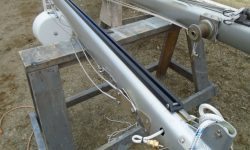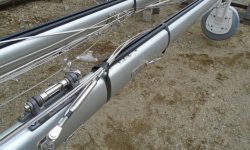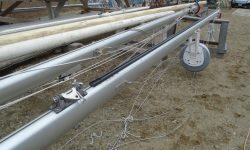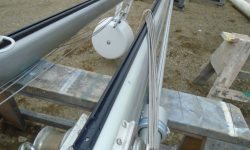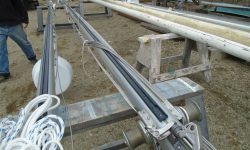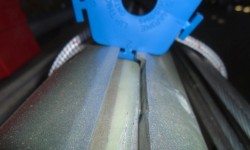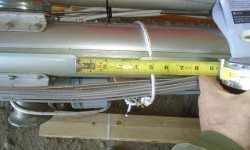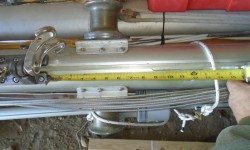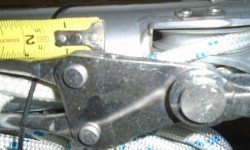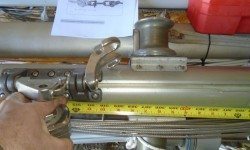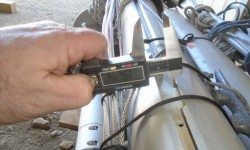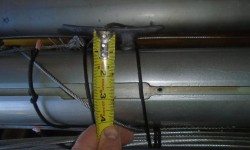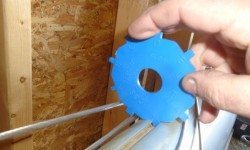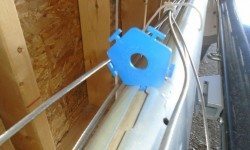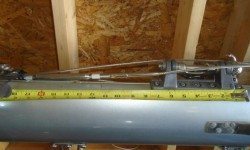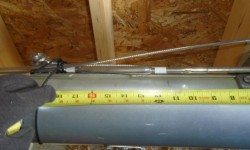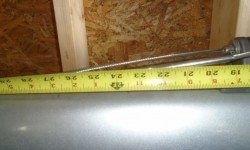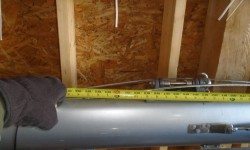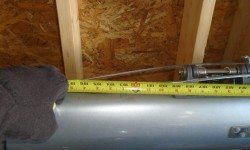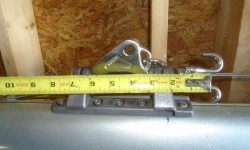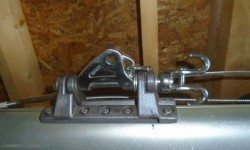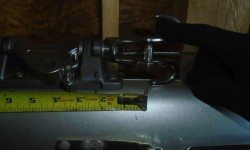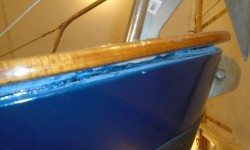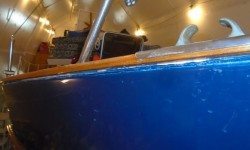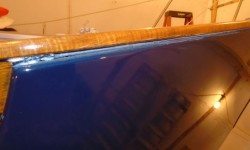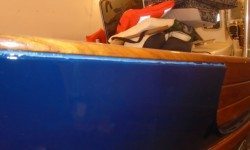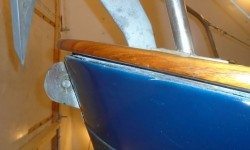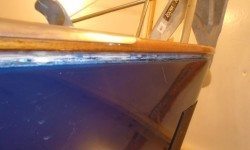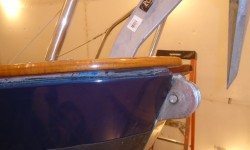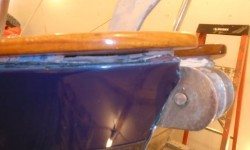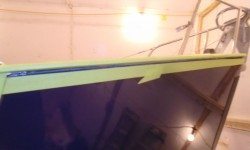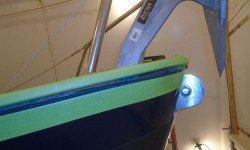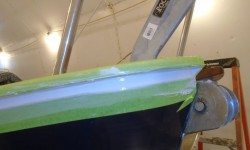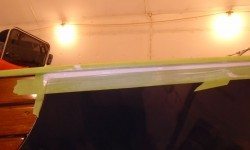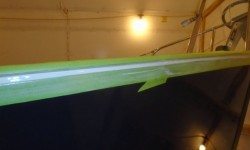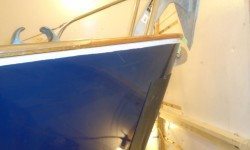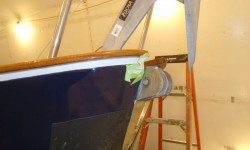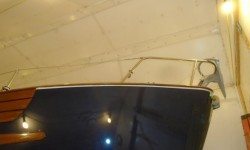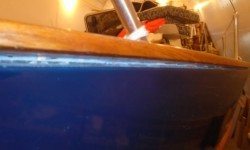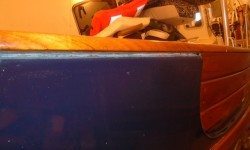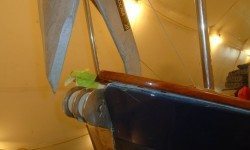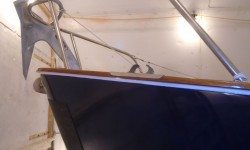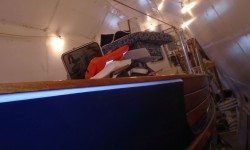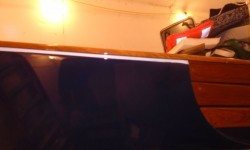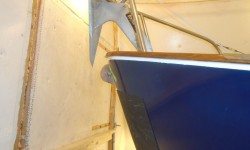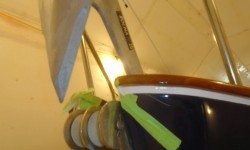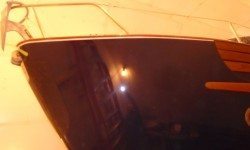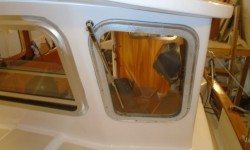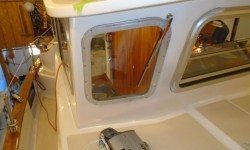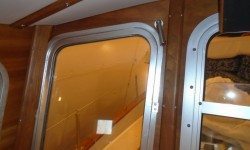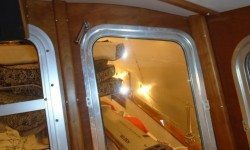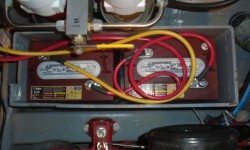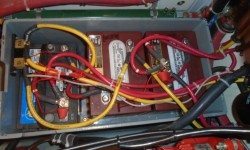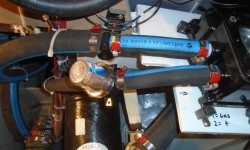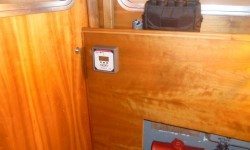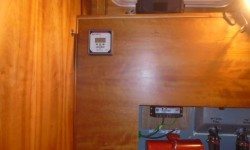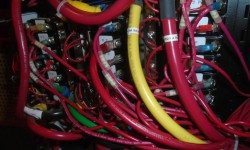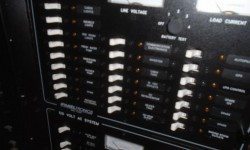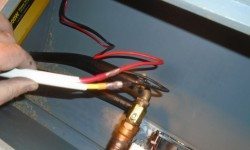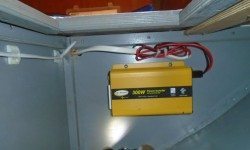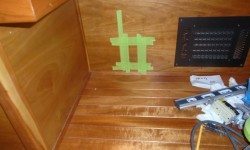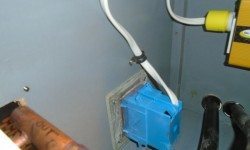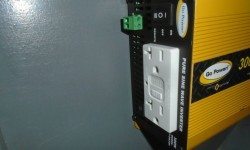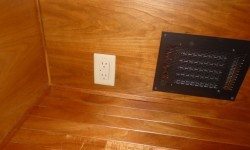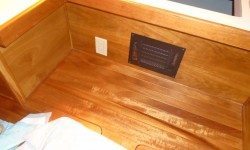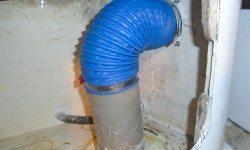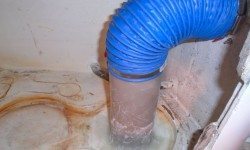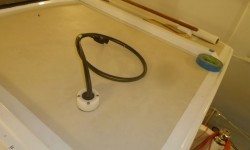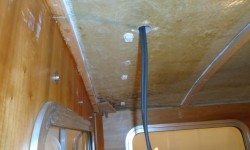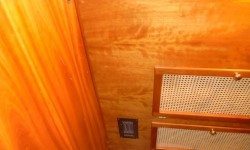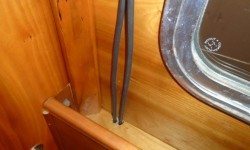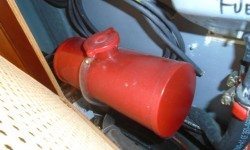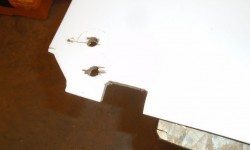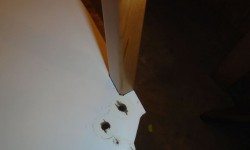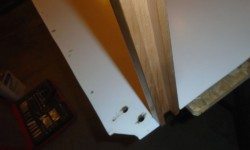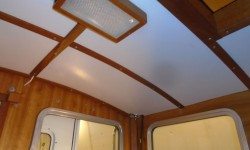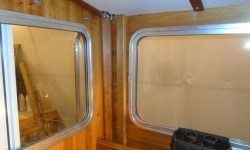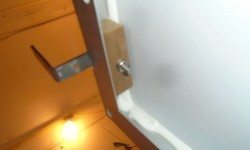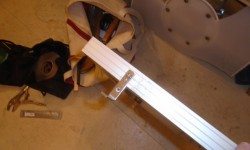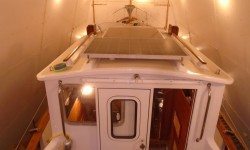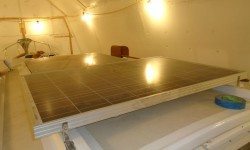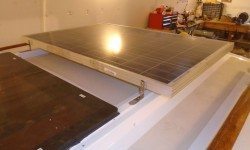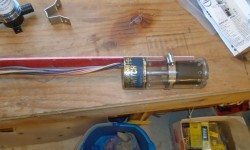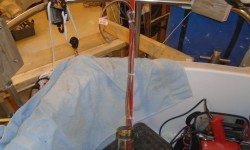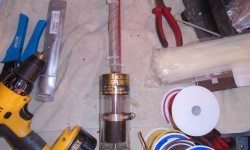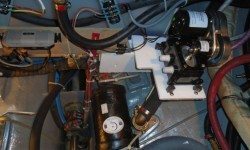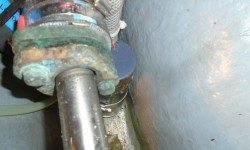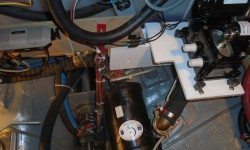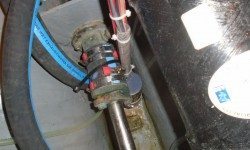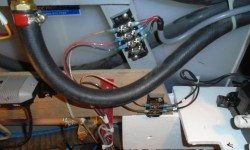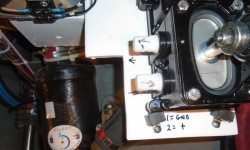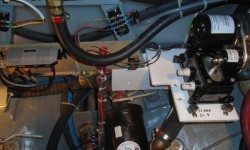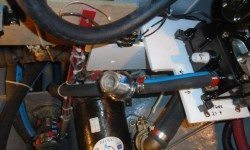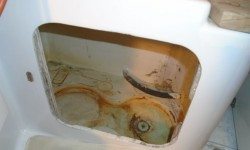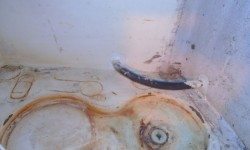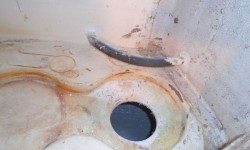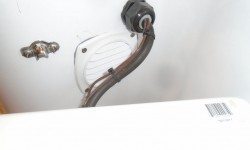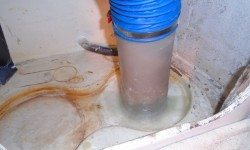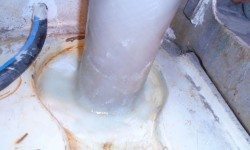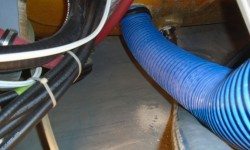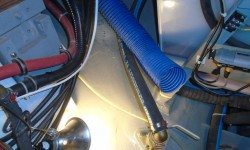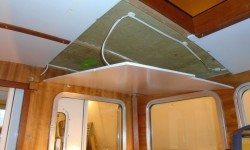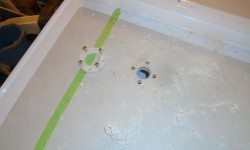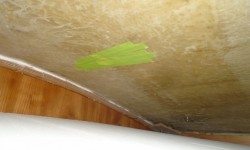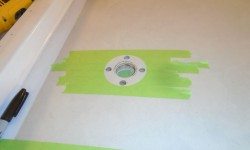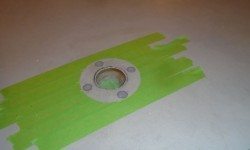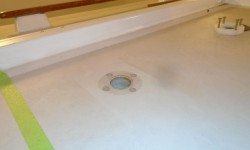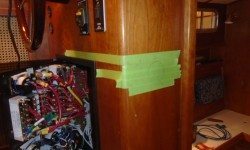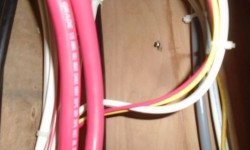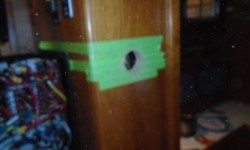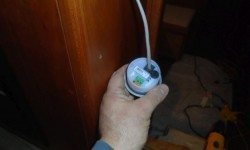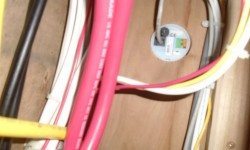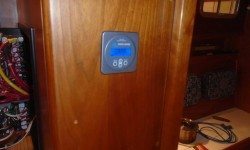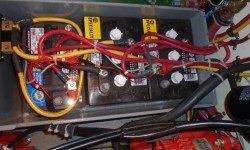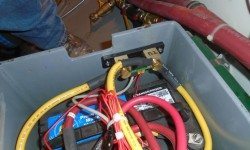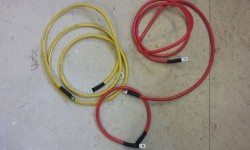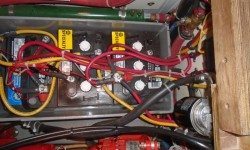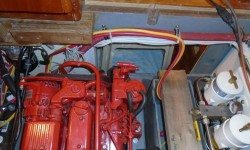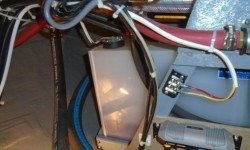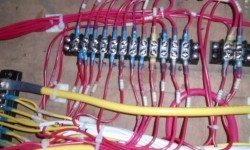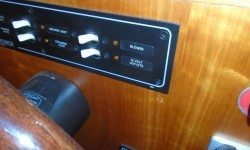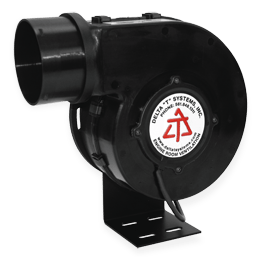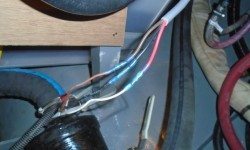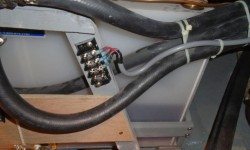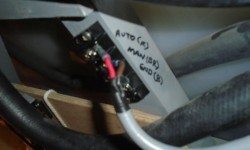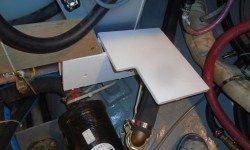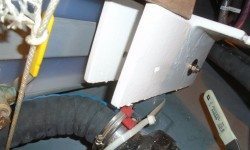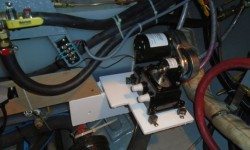< Back to Lively Heels
Thursday
The last task remaining on my work list for this off-season was to help the owner install new aftermarket sail tracks on both masts. These tracks, by Tides Marine, make sail dousing a cinch thanks to their slippery no-friction construction, which essentially allows sails to simply fall without effort.
The first step before ordering the final product was to perform various measurements of the mast and existing sail tracks. We’d planned to do this the last time I was working on the boat, but the required measuring tools from the manufacturer hadn’t yet arrived, so we postponed the measuring. With the little plastic measuring tools now on hand to determine the actual track size, we headed to the yard where the masts were in indoor–but unheated–storage. Despite one of the warmest winters on record, this day happened to be about one of the coldest of the entire season even with the late calendar date, but so it goes.
We repeated all the steps detailed below for both masts, and I’ve included specific details for each spar that might be useful for posterity.
Starting with the mainmast, the first step was to use the provided measuring tools to measure two aspects of the size and shape of the internal mast groove. In this case, we had a flat internal luff groove built into the mast, so we proceeded with the appropriate tools and directions for that type of track. According to the directions, the idea was to find the side of the measuring tool that fit the internal groove in a specific and well-defined manner, which two measurements would then indicate the size of the new track extrusion. It was a simple trial and error process till we found the right slot width (size H as shown) and slot lip thickness (size 2 as shown).
Many of the written directions were predicated on the idea that the track would be being measured and installed with the mast standing, which didn’t apply here and frankly made things much simpler from a measurement and installation standpoint, but nonetheless we went through all the motions and noted the measurements required as a matter of course. These tracks come in a large reel, and get slid up the mast track right off the reel, in theory. So to accommodate this, the instructions called for a certain minimum length to the mast gate, where sail cars (and in this case the new track) would be installed. On the mainmast, the existing mast gate was 4″ in length, which was the recommended minimum, but later we’d have to modify the gate since it was open on only one side of the sail slot, and both sides needed to be open to accommodate the new track. I’d already extended this gate once, on one side, and opening the other side would require careful cutting with a small grinder. I’d do that later, when installation time came around.
The instructions also suggested that the top of the mast gate be at least 10″ above the gooseneck, and here we had plenty of leeway.
Next, we measured for the exact length of the new track. With the instructions as a guide, we measured from a point about 1-1/2″ below the masthead sheave (which was high enough to allow the headboard cars to be raised all the way, but not so high where the track might interfere with the shackle or sheave at the top), and down to a point about 1-1/2″ above the gooseneck. The overall measurement to the gooseneck fitting itself was 310-1/4″, and subtracting an appropriate clearance at the lower end brought us to a final track measurement of 308-1/2″. One wants the bottom of the track to be as close to the gooseneck as possible, since the lower the track the lower the stack height (which is substantial with the cars used in this system) of the sail, but also high enough to allow insertion of the cars, including the 4″ long batten cars included with the system.
The final measurement requested in the ordering instructions was the internal width of the existing luff groove, a measurement that was easiest to get from a full-width slot further down the mast, which had once been used as the insertion point for the sliding gooseneck on the original boom. I used calipers and a tape to measure this at between 5/8″ and 11/16″. To allow enough space for the track to be installed, our thought was that erring towards the lower rather than higher side of this measurement would be prudent, depending on the manufacturer’s own recommendations or requirements.
Moving on to the mizzen mast, we repeated the same processes. Most elements of the mizzen extrusion were the same as the mainmast, so it was more a matter of confirming this than starting from scratch.
Mizzen mast groove measurements were, as expected, H and 2 respectively. Similarly, the overall luff groove width was the same at 5/8″ – 11/16″.
The mast gate above the new mizzen gooseneck was shorter than the required 4″ measurement, so modification would be required for that (as well as to open the other side as with the mainmast). On the mizzen, the owner wanted to lower the boom position and gooseneck from its current location, as this had turned out to be inconveniently high for sail stowage and sailcovering. In addition, he planned a new mizzen sail to replace the ratty old one, and to accommodate the new boom position, so several of our additional measurements had to account for this repositioning. We’d deterimed some months before that the new position of the gooseneck would be nearly 11-1/2″ lower than its existing position, as shown with these pencil marks.
What all this meant at the immediate moment was that the measurement to the position of the mast gate was much larger than it appeared from the existing gooseneck position. In fact, the top of the existing mast gate was 23-1/2″ above the new top of the gooseneck fitting (once it was moved).
Taking all this into account for the final track measurement, and starting with the tape about 1-1/2″ below the sheave at the masthead, we determined the overall length to to the top of the gooseneck fitting (once repositioned) to be 193″, so the track length would be slightly shorter, or 191-1/2″, ending about 1-1/2″ above the gooseneck.
Allowing for the position of the actual tack connection point on the gooseneck, and leaving room for sail stretch and to ensure that the sail could always be fully raised (i.e. not too long), the dimension for the luff length of the new mizzen would be 190″. These photos simply show the relationship and measurements of the gooseneck fitting, tack position, and boom position for reference purposes.
Total time billed on this job today: 2 hours
0600 Weather Report:
8°, clear. Forecast for the day: sunny, high around 23°


